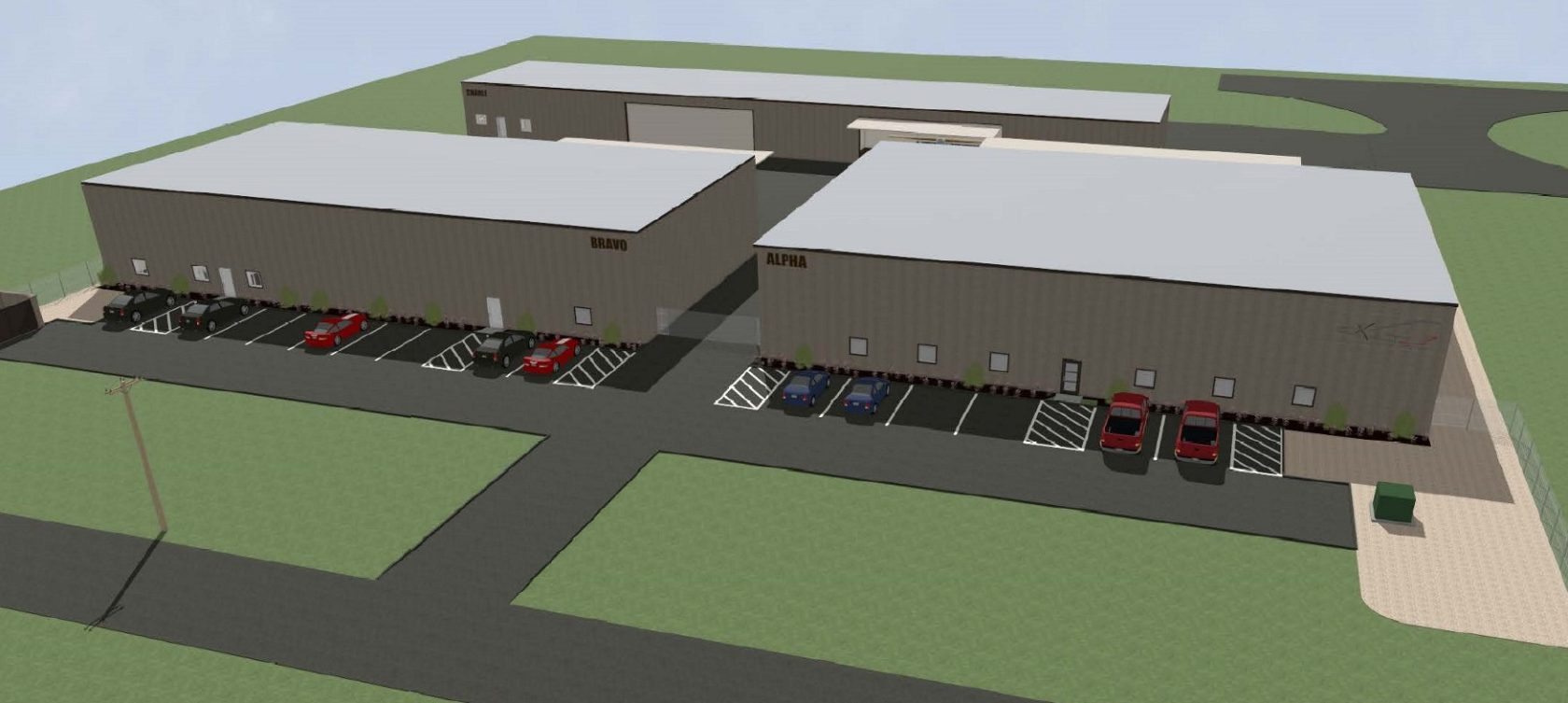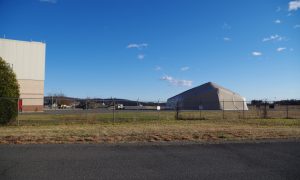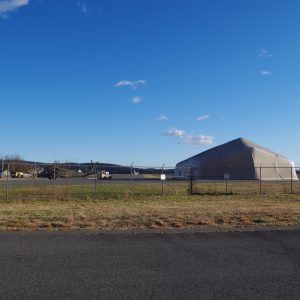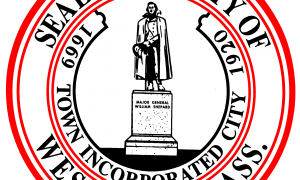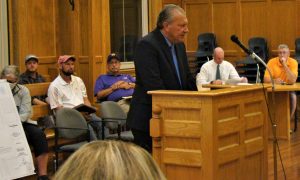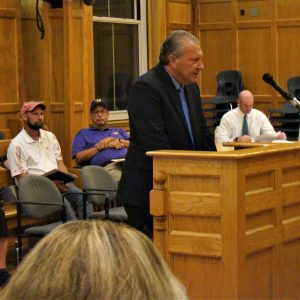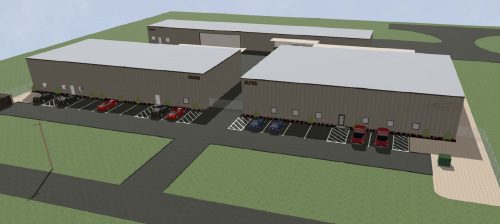
An artist’s rendering shows the three new hangars Exit 3 Aviation proposes to build at Westfield Barnes Airport. (SUBMITTED/CITY OF WESTFIELD)
WESTFIELD — A special permit and site plan for the construction of three new hangars at Westfield Barnes Airport was reviewed on Nov. 16 and then continued by the Planning Board until its meeting on Dec. 22.
Alex Colby of Exit 3 Aviation and surveyor Mark Reed from Heritage Land Surveying and Engineering said they are proposing to build three aircraft hangars on 2.39 acres at the airport, and just signed a 30-year land lease with the city and the airport in June. The hangars will be for storage of aircraft.
In June, the City Council approved a resolution from the Legislative and Ordinance Committee for lease of the airport property for the development of three aircraft hangars. L&O Chair William Onyski said at the time the resolution was needed any time an airport lease goes over 20 years, and in this case, the lease was for 20 years with two 10-year options to review.
Onyski said the Airport Commission had approved the proposal from Exit 3 Aviation to lease 2.39 acres with the intention to put up three hangars, two corporate-style hangars for business jets, and one smaller hangar. The lease was for $29,000 per year, with the price to be looked at and adjusted every three years.
At-large Councilor Dave Flaherty asked what the land is worth, and whether the land and buildings would be taxable. Onyski said the land value is based on an appraisal of airport land at 29 cents per square foot. He said the $3 to $4 million investment by the company will be taxable.
Last week, the Planning Board focused on the plan and its purpose. The project involves the construction of three airplane hangar buildings, a paved parking area with 17 parking spaces and paved airplane travel way. The parking area will be in front of the leased parcel along Airport Road. According to plans on file with the city, the hangars will by 129 by 92 feet, 139 by 67 feet, and 235 by 45 feet.
Colby said the buildings themselves will be steel buildings with four-inch slip blocks on the exterior and a rubber roof over steel and insulation.
In response to a question, Colby said the largest plane to be housed in the hangar would be a 40-foot six-person private jet, a Citation Mustang. He said the hangars are not large enough to fit a large corporate jet. Altogether a combination of 15 jets and propeller planes will be stored in the three hangars.
The hangars will have access directly from Airport Road, and won’t go through any existing gates, but will have their own gates.
Planning Board Chair William Carellas then opened the hearing to the public, and at-large Councilor Kristen Mello asked questions that she had been asked to hold for the Planning Board during the discussion of the lease.
Mello asked whether the requirement of no more than 70 percent impervious surface at the airport applied to each project or to the airport as a whole, because she said this project shows 85 percent impervious surface. City Planner Jay Vinskey said it applied to the whole airport.
“Each time the airport gets developed, it cuts into that 70 percent. It could get to the point where 70 percent of the whole acreage is paved, and that would cap [development],” Vinskey said.
Mello also asked what fire suppression would be used, and how the stormwater system would prevent chemicals from leaching into the groundwater. The site is over the aquifer.
Colby said Exit 3 Aviation will use straight water in its fire suppression system, which will be tested once a year, and there is a shutoff with a key for all of the catch basins, to prevent any spills from going into the ground.
Carellas asked what if there were a jet fuel leak from a plane. Reed said the stormwater plan has three different stopgaps to prevent any contamination from going into the aquifer. They all have oil and water separators that go into a drainage system, and then into another system. The valve which can be closed is in the third stop gate. He said the plan conforms with the airport’s master plan, and was approved by the city Engineering Department.
Colby said there will be no cleaning of planes at the site, and no direct discharge due to impervious surfaces onto adjoining land, and no sheet flow coming off the property.
Asked how many gallons of fuel the planes hold when full, he said 50 to 200 gallons. The containment system is designed to handle the 200 gallons in the piping structure if the gate valve is closed. Asked whether someone will be there if there is a leak, he said the tool for the gate valves will be on the outside of the building, and all of the tenants will know how to shut it off.
Airport Manager Christopher Willenborg said if there is a spill at the airport, emergency response procedures require the valve to be closed, containing the hazardous material in that area until an environmental company is brought in to clean it up.
When asked why the valve couldn’t be closed all the time, Reed said it is kept open to allow regular rainwater to drain through the system.
Carellas asked how often stored airplanes leak fuel. Willenborg said it did not happen in a hangar when no one was there. Outside, with an airplane on a runway, there may be small spills.
Willenborg said if there is a spill, the aircraft owner is responsible for the environmental cleanup, which is also the language in the lease agreement with Exit 3.
“For example, we had an aircraft accidently hit a sign, and the owner was responsible for that,” he said.
Asked what happens if there is a fire, Willenborg said the airport is cognizant of the opposition to using foam, and will try to use water. Once safe and secure, they will call the environmental company and the state Department of Environmental Protection. He said the insurance carrier and aircraft owner would be responsible.
Mello asked if there will be curbage around the Exit 3 area to contain leaks or fires. Reed said there would be curbs around the perimeter of the pavement area, and that the pavement is pitched towards the catchment basins.
Following no further questions, Vinskey said the board had not yet received a comment from the Water Commission or the Board of Health. According to the ordinance, the Planning Board needs to defer final action until they have heard from them, or 35 days have elapsed.
No action was taken, and the hearing was continued until Dec. 22.

